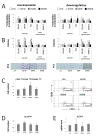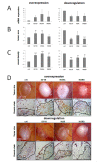Oncogenic functions of IGF1R and INSR in prostate cancer include enhanced tumor growth, cell migration and angiogenesis
- PMID: 24809298
- PMCID: PMC4058040
- DOI: 10.18632/oncotarget.1884
Oncogenic functions of IGF1R and INSR in prostate cancer include enhanced tumor growth, cell migration and angiogenesis
Abstract
We scrutinized the effect of insulin receptor (INSR) in addition to IGF1R in PCa using in vitro and in vivo models. In-vitro overexpression of IGF1R and INSRA, but not INSRB increased cell proliferation, colony formation, migration, invasion and resistance to apoptosis in prostate cancer cells (DU145, LNCaP, PC3). Opposite effects were induced by downregulation of IGF1R and total INSR, but not INSRB. In contrast to tumor cells, non-cancerous epithelial cells of the prostate (EP156T, RWPE-1) were inhibited on overexpression and stimulated by knockdown of receptors. In-vivo analyses using the chicken allantoic membrane assay confirmed the tumorigenic effects of IGF1R and INSR. Apart of promoting tumor growth, IGF1R and INSR overexpression also enhanced angiogenesis indicated by higher vessel density and increased number of desmin-immunoreactive pericytes. Our study underscores the oncogenic impact of IGF1R including significant effects on tumor growth, cell migration, sensitivity to apoptotic/chemotherapeutic agents and angiogenesis, and characterizes the INSR, in particular the isoform INSRA, as additional cancer-promoting receptor in prostate cancer. Both, the insulin-like growth factor receptor 1 and the insulin receptor exert oncogenic functions, thus proposing that both receptors need to be considered in therapeutic settings.
Figures



Similar articles
-
Both IGF1R and INSR Knockdown Exert Antitumorigenic Effects in Prostate Cancer In Vitro and In Vivo.Mol Endocrinol. 2015 Dec;29(12):1694-707. doi: 10.1210/me.2015-1073. Epub 2015 Oct 9. Mol Endocrinol. 2015. PMID: 26452103 Free PMC article.
-
Diverse functions of IGF/insulin signaling in malignant and noncancerous prostate cells: proliferation in cancer cells and differentiation in noncancerous cells.Endocrinology. 2012 Oct;153(10):4633-43. doi: 10.1210/en.2012-1348. Epub 2012 Aug 17. Endocrinology. 2012. PMID: 22903612
-
Systems Analysis of Insulin and IGF1 Receptors Networks in Breast Cancer Cells Identifies Commonalities and Divergences in Expression Patterns.Front Endocrinol (Lausanne). 2020 Jul 7;11:435. doi: 10.3389/fendo.2020.00435. eCollection 2020. Front Endocrinol (Lausanne). 2020. PMID: 32733384 Free PMC article.
-
Minireview: nuclear insulin and insulin-like growth factor-1 receptors: a novel paradigm in signal transduction.Endocrinology. 2013 May;154(5):1672-9. doi: 10.1210/en.2012-2165. Epub 2013 Mar 18. Endocrinology. 2013. PMID: 23507573 Review.
-
The Role of Nuclear Insulin and IGF1 Receptors in Metabolism and Cancer.Biomolecules. 2021 Apr 2;11(4):531. doi: 10.3390/biom11040531. Biomolecules. 2021. PMID: 33918477 Free PMC article. Review.
Cited by
-
Mouse liver sinusoidal endothelial cell responses to the glucocorticoid receptor agonist dexamethasone.Front Pharmacol. 2024 Oct 8;15:1377136. doi: 10.3389/fphar.2024.1377136. eCollection 2024. Front Pharmacol. 2024. PMID: 39439887 Free PMC article.
-
Insulin-like growth factor 1 receptor expression correlates with programmed death ligand 1 expression and poor survival in non-small cell lung cancer.PLoS One. 2024 Oct 4;19(10):e0297397. doi: 10.1371/journal.pone.0297397. eCollection 2024. PLoS One. 2024. PMID: 39365756 Free PMC article.
-
Current landscape of exosomal non-coding RNAs in prostate cancer: Modulators and biomarkers.Noncoding RNA Res. 2024 Jul 20;9(4):1351-1362. doi: 10.1016/j.ncrna.2024.07.003. eCollection 2024 Dec. Noncoding RNA Res. 2024. PMID: 39247145 Free PMC article. Review.
-
R-loop resolution by ARIP4 helicase promotes androgen-mediated transcription induction.Sci Adv. 2024 Jul 19;10(29):eadm9577. doi: 10.1126/sciadv.adm9577. Epub 2024 Jul 19. Sci Adv. 2024. PMID: 39028815 Free PMC article.
-
Therapeutic targets of formononetin for treating prostate cancer at the single-cell level.Aging (Albany NY). 2024 Jun 13;16(12):10380-10401. doi: 10.18632/aging.205935. Epub 2024 Jun 13. Aging (Albany NY). 2024. PMID: 38874510 Free PMC article.
References
-
- Siegel R, Naishadham D, Jemal A. Cancer statistics, 2013. CA Cancer J Clin. 2013;63(1):11–30. - PubMed
-
- Nabhan C, Parsons B, Touloukian EZ, Stadler WM. Novel approaches and future directions in castration-resistant prostate cancer. Ann Oncol. 2011;22(9):1948–1957. - PubMed
-
- Pollak M. Insulin and insulin-like growth factor signalling in neoplasia. Nat Rev Cancer. 2008;8(12):915–928. - PubMed
Publication types
MeSH terms
Substances
Grants and funding
LinkOut - more resources
Full Text Sources
Other Literature Sources
Medical
Miscellaneous

